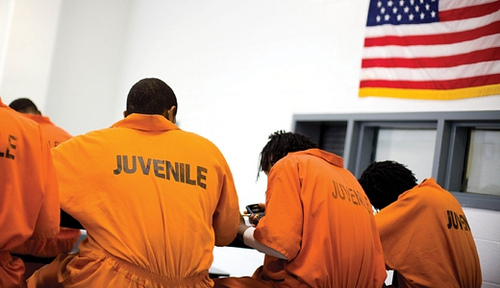by Elizabeth S. Scott & Laurence Steinberg
The New York Times
Friday, November 13, 2009
ON Monday, the United States Supreme Court heard oral arguments in two cases that ask whether sentencing a juvenile to life in prison without the possibility of parole is a violation of the Eighth Amendment’s prohibition of cruel and unusual punishment.
Those who hope the court will ban this sort of sentencing point to the 2005 decision in Roper v. Simmons, in which the court abolished the juvenile death penalty. They believe that the logic the justices applied in Roper to exclude minors from capital punishment should extend to life without parole as well.
Those who hope the justices will retain life sentences for juveniles argue that “death is different,” and that the court should exercise restraint, as it typically does when reviewing non-capital sentencing decisions for fairness under the proportionality principle.
Certainly, death is different. But the sentence of life in prison without parole is also different from even lengthy conventional sentences; it is a judgment that an offender will never be fit to rejoin civil society, however long he lives. This punishment may be suitable for adults who have committed terrible crimes, but it is never a fair sentence for a juvenile, whose character is unformed and whose involvement in crime reflects the immature judgment of adolescence.
A crucial lesson of the Roper case is that the developmental differences between adolescents and adults are important under the Eighth Amendment, as they are in other areas of constitutional law. In deciding to end the juvenile death penalty, the court repeatedly emphasized the relative immaturity of minors, even at age 17, as compared to adults — a point that is well established in behavioral research and finds growing support in brain science.
Writing for the majority in Roper, Justice Anthony Kennedy observed that juveniles’ impulsivity, recklessness and susceptibility to peer pressure made them inherently less responsible than adults. Justice Kennedy also noted juveniles’ potential for rehabilitation, because their personality and character traits are less fixed than adults.
In the years since the Roper ruling, research on adolescent brain and behavioral development has provided additional support for Justice Kennedy’s observations. There is now a consensus among neuroscientists, for example, that brain regions and systems responsible for foresight, self-regulation, risk assessment and responsiveness to social influences continue to mature into young adulthood. This evidence that adolescents are psychologically and neurologically less mature than adults should be important in deciding how to punish their criminal acts.
In Monday’s oral argument, the justices did not question the proposition that juveniles generally are psychologically less mature than adults. The debate focused instead on whether the mitigating trait of immaturity justified a categorical exclusion of juveniles from the sentence of life without parole.
Some justices argued instead that age and maturity should be considered in sentencing on a case-by-case basis. But this approach was rejected by the court in Roper — and it should be rejected here as well. As Roper recognized, even psychological experts are unable to distinguish between the young person whose crime reflects transient immaturity and the rare juvenile offender who may deserve the harsh sentence of life without parole. If experts can’t reliably make this determination, then it seems unlikely that juries and judges would be able to do much better.
The two Florida offenders whose cases will be decided by the court differ in age and in their offenses: Terrance Graham was sentenced to life without parole for a probation violation involving a house break-in at age 17, while Joe Sullivan was convicted of sexual assault at age 13.
It is possible that the court will treat these two cases differently. But in both cases, the lower court decisions should be struck down. For a minor to be confined in prison for life with no possibility of ever having the opportunity to demonstrate that he should be allowed to rejoin society is an egregious violation of the Eighth Amendment, especially for a crime in which no life was lost.
Such a sentence offends “the evolving standards of decency that mark the progress of a maturing society,” the court’s announced standard for reviewing state punishment under the Eighth Amendment. Indeed, in our opinion, life without parole is never a fair sentence for a juvenile, even in a murder case.
There is no question that teenagers who commit serious crimes should be held accountable and punished, and that society must be protected from young people who are violent and dangerous. But studies show that the vast majority of juveniles who commit crimes — even very serious crimes — grow up to be law-abiding adults, and that it is impossible to predict which juvenile offenders will become career criminals.
Absent an ability to do this, and in light of what science tells us about the capacity for adolescents to change, it makes no sense to lock up any young offender and throw away the key.
Source: http://www.nytimes.com/2009/11/14/opinion/14scott.html





















